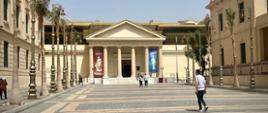Visits to cultural institutions
20.04.2024
On April 17, representatives of the Polish Embassy in Cairo visited Alexandria, during which they had meetings with the authorities of two distinguished local cultural institutions - the Graeco Roman Museum and Bibliotheca Alexandrina. Additionally, they visited the Polish archaeological mission of the Polish Centre of Mediterranean Archaeology, working at the Kom el-Dikka site.

At the Graeco Roman Museum, we were hosted by Dr. Walaa Mostafa, the Museum Director, who also guided us through the exhibition. The museum opened in November of last year after several years of renovation. It is one of the most interesting museums in Egypt, with exhibitions organized exceptionally professionally, with a sparing yet thoughtful use of multimedia, which allowed for a balance between traditional and multimedia exhibition forms. Dr. Mostafa was sincerely enthusiastic about establishing cooperation both with the Embassy and with museum partners from Poland.
http://www.alexandria.gov.eg/Alex/english/Graeco%20Roman%20Museum.html
At the Bibliotheca Alexandrina, we were received by its Director, Ahmed Zayed. The library is the largest institution of its kind in the region, with a much broader range of activities than a traditional library, including cultural, exhibition, and scientific activities, etc. The meeting took place in a very good atmosphere, and the Bibliotheca expressed readiness to cooperate on exhibition or cultural initiatives.
www.bibalex.org
We also had the opportunity to visit the archaeological site of Kom el-Dikka, where since 1960, experts from the Center for Mediterranean Archaeology at the University of Warsaw, currently under the direction of Dr. Grzegorz Majcherek, have been conducting research and reconstruction work aimed at transforming the site into an archaeological park. Kom el-Dikka, located in the center of modern Alexandria, is not only the largest but above all the only archaeological site that offers opportunities to understand the fabric of this ancient city in a broader urban context. The results of excavation work lasting for over half a century have allowed for a better understanding of the metropolis' past, ranging from topography and architecture to the daily life of its inhabitants, over the long span of history, from the 2nd century BCE to the 14th century CE.
https://pcma.uw.edu.pl/





